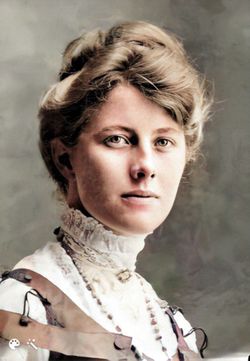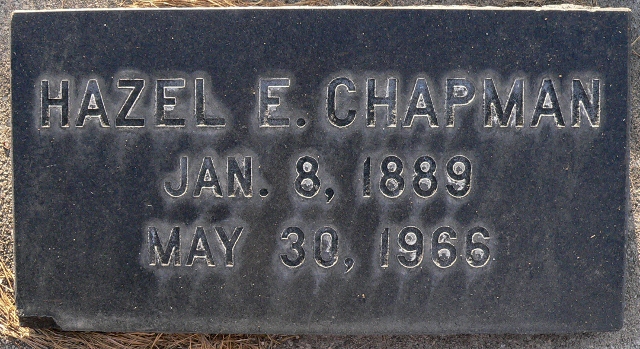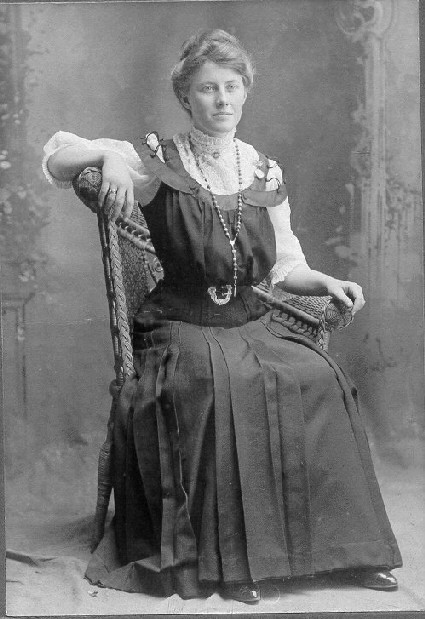In searching her memory, the first thing she remembers was the death of her grandfather James P. Carter.
Her family consisted of ten children. The oldest child being Mosiah David Evans, and followed by Esther Maud Evans Foulger, Howard Evans, and then Hazel May Evans Chapman in the order, Eleazer Carter Evans, John Roscoe Evans, Glen Merrill Evans, Earl William Evans, Jessie Evans Dickenson and Lyra Alice Evans. Lyra died as an infant. This family was a large and very happy one.
Hazel remembers being teased mercilessly by her older brother and sisters, but admits she also did some teasing of the younger ones herself.
With four younger brothers, and a baby sister, she came in for a good share of baby tending. The family lived near some railroad tracks and the children had to be watched carefully.
Hazel had the job of giving the four younger boys their baths in the summer kitchen. She relates that it was a trying and slippery job. One time she remembers pouring very cold water on them to make them behave. Keeping the little ears and necks clean was a never-ending problem.
She remembers a terrifying incident that happened one day. Her father's office was located a block and a half from where they lived. On this fateful day, her mother was cooking in the kitchen, she glanced up and discovered that the ceiling was on fire. She calmly told Hazel to run to get her father. This happened in the days when there were no fire engines, nor even hoses, only bucket brigades. Hazel ran screaming for her father and must have made quite a sight running down the road, because some of her friends teased her about it later on. Luckily the fire was controlled and little damage done.
Hazel's father, Mosiah, was a very patient and lovable man. He was very tender with all of his children. there were large Cottonwood trees near their house in Lehi, and one spring some robins nested there. The children all had many questions about the noisy nesting birds. Father Mosiah carried all the children up the tree to have a look right into the nests. The cottonwood trees, being so large, must have presented a climbing problem. But Mosiah gently made the trips until each child was satisfied.
When Hazel was thirteen years old, her family moved from Lehi to Garland, Utah in the northern part of the state.
Hazel's mother became dangerously ill when she was having her last baby -- Lyra. Hazel hitched up the horse to the cart and taking her sisters Essie and Jessie, took them for a ride to keep them out from underfoot at home. when they returned the baby had been born and died. Hazel was very conscientious and tried to assume here mother's duties while she was ill. She prepared the meals, took the children to school in the buggy because they lived some distance from the school. She also got the older boys off to their work at the Garland Sugar factory. Her toughest assignment was to take the little baby, Lyra, and wash and dress her to prepare her for burial. At the time Hazel was only 16 years old. She was so haunted by the dead infant that her parents sent her off for a vacation to Lehi to help her forget.
In some ways the young Hazel was a little rascal. A problem came up in the family, as to who should milk the cow each day. The boys all went to work too early, the other children were too young, and her father had a cramped thumb. Hazel was asked to do the chore. She spent some time trying to figure out how to get out of it, and then she worked her strategy to perfection. Her father went with her to the barn to give her instructions and to supervise. They got the cow lined up and gave her some hay to eat, then Hazel sat down and started the milking by squeezing her long finger nails into the cow. The cow was startled and kicked Hazel, the bucket, and the stool over. Hazel cried loud and long and never milked the cow again as long as she lived.
Hazel was also clever in figuring out just how to get what she wanted. There was no high school n Garland and she desired very much to go to high school. She sat down and wrote a very long ungrammatical letter to her father to try to convince him that she should go. She won her case. Her father asked her "Did you write this letter with your foot?"
She received two years of high school in Salt Lake City, and then she had to return to Garland to assist her mother.
In the year 1908, young David Chapman was brought up to Garland to assist in the office of the Garland Sugar Company. Hazel and David met at church and began a courtship. They married in Salt Lake City, in the temple on September 1, 1909.
Five children were born to this union. The first child was Esther Chapman Jensen, followed by Virginia Chapman Wood, Carol Chapman Schoenhals, David Marden Chapman and Eugene Henry Chapman.
Sewing was a special talent for Hazel Evans Chapman. She was an excellent seamstress. She sewed for her sisters, her own children, and even darling little clothes for her grandchildren. She made a lot of her own patterns. She was a welcome member of any Relief Society that she lived near. Her clever ideas in making things made her a leader of the group.
Traveling was a special hobby for Hazel. She loved it all through her life. One of her favorite spots was the "Lone Cypress Tree by the Sea." The tree stands on a point overlooking the Pacific ocean, and can be reached by driving along the "seventeen mile drive" down by Carmel, California.
She used to travel with a friend named Geneve, and because they had trouble remembering the time changes as they traveled in different time zones, they used to each set their watch at a different time. One would wear Standard time on her watch and the other would wear Eastern time. That way they could always keep track of the time changes.
Hazel's son Eugene was taken into the army in 1951. He was stationed in San Antonio, Texas before being sent overseas. Hazel and her daughter-in-law, Marilyn, drove to Texas to be with him for six weeks before he shipped out. They noticed a beautiful cactus growing alongside the road while the trip. They decided to stop and see if they could dig it up to take home for a souvenir. It wasn't long before they had it safely stored in the truck. When they arrived in San Antonio, they opened the trunk and found it full of hundreds of ants from the cactus. The ants proved quite messy to get rid of, and the cactus did not come home to Utah as a souvenir. While in Texas they all visited the Alamo, and they enjoyed the most luscious, juicy, T-bone steaks.
Hazel Chapman has a green thumb when it comes to raising African Violets. She can grow gigantic blossoms, and all colors in delicate shades and hues. She is famous for her beautiful plants.
The nickname that has been attached to her as long as I have known her is "Nama". Everyone calls her this, from her own children down to her grandchildren. She is beloved by all for her sweet personality, her friendliness, and her practical charm.
Baby tending has also been a very gifted talent for her. She has a way of appealing to any child. Her grand-daughter, Carolyn Schoenhals, remembers make believe picnics they were great fun. They would make salads out of grass. They would use sticks for meat, and rocks for potatoes. Such is her way with children. On her 73rd birthday in 1962 she received the following poem from this same granddaughter. It tells very sweetly how much inspiration she receives from "Nama".
So many of my memories
Contain a glimpse of you---
My Nama's helped to shape my life
And been my good friend too.
When I was just a tiny tot
No more than two or three
We'd make our salads out of grass,
And sip a cup of tea.
You stitched for me the cutest clothes,
And made me want to know.
It must have been a trial,
But thanks to you I sew.
You have a sense of humor
That often makes me smile
And you will always listen
To my prattle for a while.
And so upon this birthday,
I'd sincerely like to say,
Thanks to you for all you've done
For me, in your special way.
In searching her memory, the first thing she remembers was the death of her grandfather James P. Carter.
Her family consisted of ten children. The oldest child being Mosiah David Evans, and followed by Esther Maud Evans Foulger, Howard Evans, and then Hazel May Evans Chapman in the order, Eleazer Carter Evans, John Roscoe Evans, Glen Merrill Evans, Earl William Evans, Jessie Evans Dickenson and Lyra Alice Evans. Lyra died as an infant. This family was a large and very happy one.
Hazel remembers being teased mercilessly by her older brother and sisters, but admits she also did some teasing of the younger ones herself.
With four younger brothers, and a baby sister, she came in for a good share of baby tending. The family lived near some railroad tracks and the children had to be watched carefully.
Hazel had the job of giving the four younger boys their baths in the summer kitchen. She relates that it was a trying and slippery job. One time she remembers pouring very cold water on them to make them behave. Keeping the little ears and necks clean was a never-ending problem.
She remembers a terrifying incident that happened one day. Her father's office was located a block and a half from where they lived. On this fateful day, her mother was cooking in the kitchen, she glanced up and discovered that the ceiling was on fire. She calmly told Hazel to run to get her father. This happened in the days when there were no fire engines, nor even hoses, only bucket brigades. Hazel ran screaming for her father and must have made quite a sight running down the road, because some of her friends teased her about it later on. Luckily the fire was controlled and little damage done.
Hazel's father, Mosiah, was a very patient and lovable man. He was very tender with all of his children. there were large Cottonwood trees near their house in Lehi, and one spring some robins nested there. The children all had many questions about the noisy nesting birds. Father Mosiah carried all the children up the tree to have a look right into the nests. The cottonwood trees, being so large, must have presented a climbing problem. But Mosiah gently made the trips until each child was satisfied.
When Hazel was thirteen years old, her family moved from Lehi to Garland, Utah in the northern part of the state.
Hazel's mother became dangerously ill when she was having her last baby -- Lyra. Hazel hitched up the horse to the cart and taking her sisters Essie and Jessie, took them for a ride to keep them out from underfoot at home. when they returned the baby had been born and died. Hazel was very conscientious and tried to assume here mother's duties while she was ill. She prepared the meals, took the children to school in the buggy because they lived some distance from the school. She also got the older boys off to their work at the Garland Sugar factory. Her toughest assignment was to take the little baby, Lyra, and wash and dress her to prepare her for burial. At the time Hazel was only 16 years old. She was so haunted by the dead infant that her parents sent her off for a vacation to Lehi to help her forget.
In some ways the young Hazel was a little rascal. A problem came up in the family, as to who should milk the cow each day. The boys all went to work too early, the other children were too young, and her father had a cramped thumb. Hazel was asked to do the chore. She spent some time trying to figure out how to get out of it, and then she worked her strategy to perfection. Her father went with her to the barn to give her instructions and to supervise. They got the cow lined up and gave her some hay to eat, then Hazel sat down and started the milking by squeezing her long finger nails into the cow. The cow was startled and kicked Hazel, the bucket, and the stool over. Hazel cried loud and long and never milked the cow again as long as she lived.
Hazel was also clever in figuring out just how to get what she wanted. There was no high school n Garland and she desired very much to go to high school. She sat down and wrote a very long ungrammatical letter to her father to try to convince him that she should go. She won her case. Her father asked her "Did you write this letter with your foot?"
She received two years of high school in Salt Lake City, and then she had to return to Garland to assist her mother.
In the year 1908, young David Chapman was brought up to Garland to assist in the office of the Garland Sugar Company. Hazel and David met at church and began a courtship. They married in Salt Lake City, in the temple on September 1, 1909.
Five children were born to this union. The first child was Esther Chapman Jensen, followed by Virginia Chapman Wood, Carol Chapman Schoenhals, David Marden Chapman and Eugene Henry Chapman.
Sewing was a special talent for Hazel Evans Chapman. She was an excellent seamstress. She sewed for her sisters, her own children, and even darling little clothes for her grandchildren. She made a lot of her own patterns. She was a welcome member of any Relief Society that she lived near. Her clever ideas in making things made her a leader of the group.
Traveling was a special hobby for Hazel. She loved it all through her life. One of her favorite spots was the "Lone Cypress Tree by the Sea." The tree stands on a point overlooking the Pacific ocean, and can be reached by driving along the "seventeen mile drive" down by Carmel, California.
She used to travel with a friend named Geneve, and because they had trouble remembering the time changes as they traveled in different time zones, they used to each set their watch at a different time. One would wear Standard time on her watch and the other would wear Eastern time. That way they could always keep track of the time changes.
Hazel's son Eugene was taken into the army in 1951. He was stationed in San Antonio, Texas before being sent overseas. Hazel and her daughter-in-law, Marilyn, drove to Texas to be with him for six weeks before he shipped out. They noticed a beautiful cactus growing alongside the road while the trip. They decided to stop and see if they could dig it up to take home for a souvenir. It wasn't long before they had it safely stored in the truck. When they arrived in San Antonio, they opened the trunk and found it full of hundreds of ants from the cactus. The ants proved quite messy to get rid of, and the cactus did not come home to Utah as a souvenir. While in Texas they all visited the Alamo, and they enjoyed the most luscious, juicy, T-bone steaks.
Hazel Chapman has a green thumb when it comes to raising African Violets. She can grow gigantic blossoms, and all colors in delicate shades and hues. She is famous for her beautiful plants.
The nickname that has been attached to her as long as I have known her is "Nama". Everyone calls her this, from her own children down to her grandchildren. She is beloved by all for her sweet personality, her friendliness, and her practical charm.
Baby tending has also been a very gifted talent for her. She has a way of appealing to any child. Her grand-daughter, Carolyn Schoenhals, remembers make believe picnics they were great fun. They would make salads out of grass. They would use sticks for meat, and rocks for potatoes. Such is her way with children. On her 73rd birthday in 1962 she received the following poem from this same granddaughter. It tells very sweetly how much inspiration she receives from "Nama".
So many of my memories
Contain a glimpse of you---
My Nama's helped to shape my life
And been my good friend too.
When I was just a tiny tot
No more than two or three
We'd make our salads out of grass,
And sip a cup of tea.
You stitched for me the cutest clothes,
And made me want to know.
It must have been a trial,
But thanks to you I sew.
You have a sense of humor
That often makes me smile
And you will always listen
To my prattle for a while.
And so upon this birthday,
I'd sincerely like to say,
Thanks to you for all you've done
For me, in your special way.
Family Members
Sponsored by Ancestry
Advertisement
Explore more
Sponsored by Ancestry
Advertisement





















